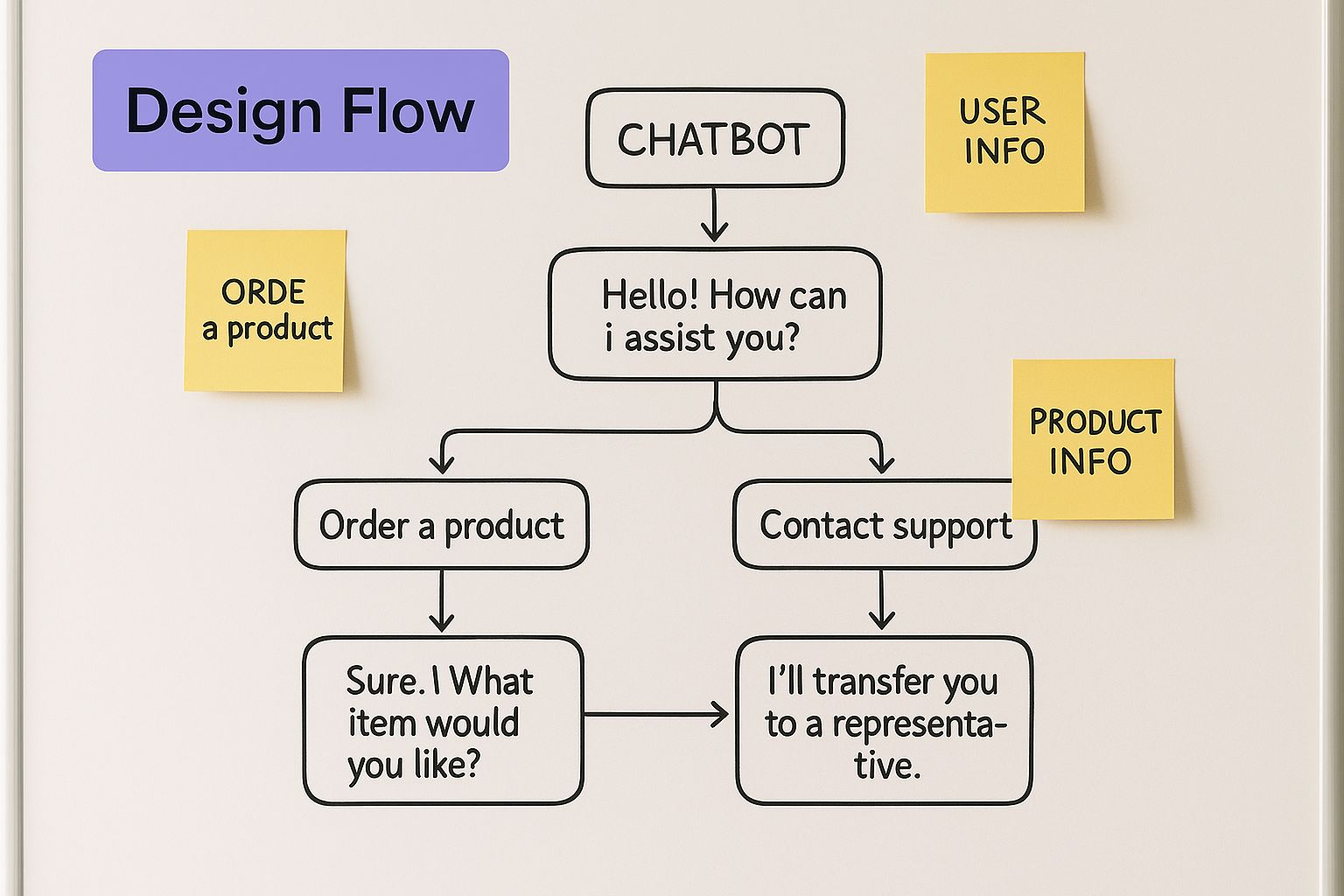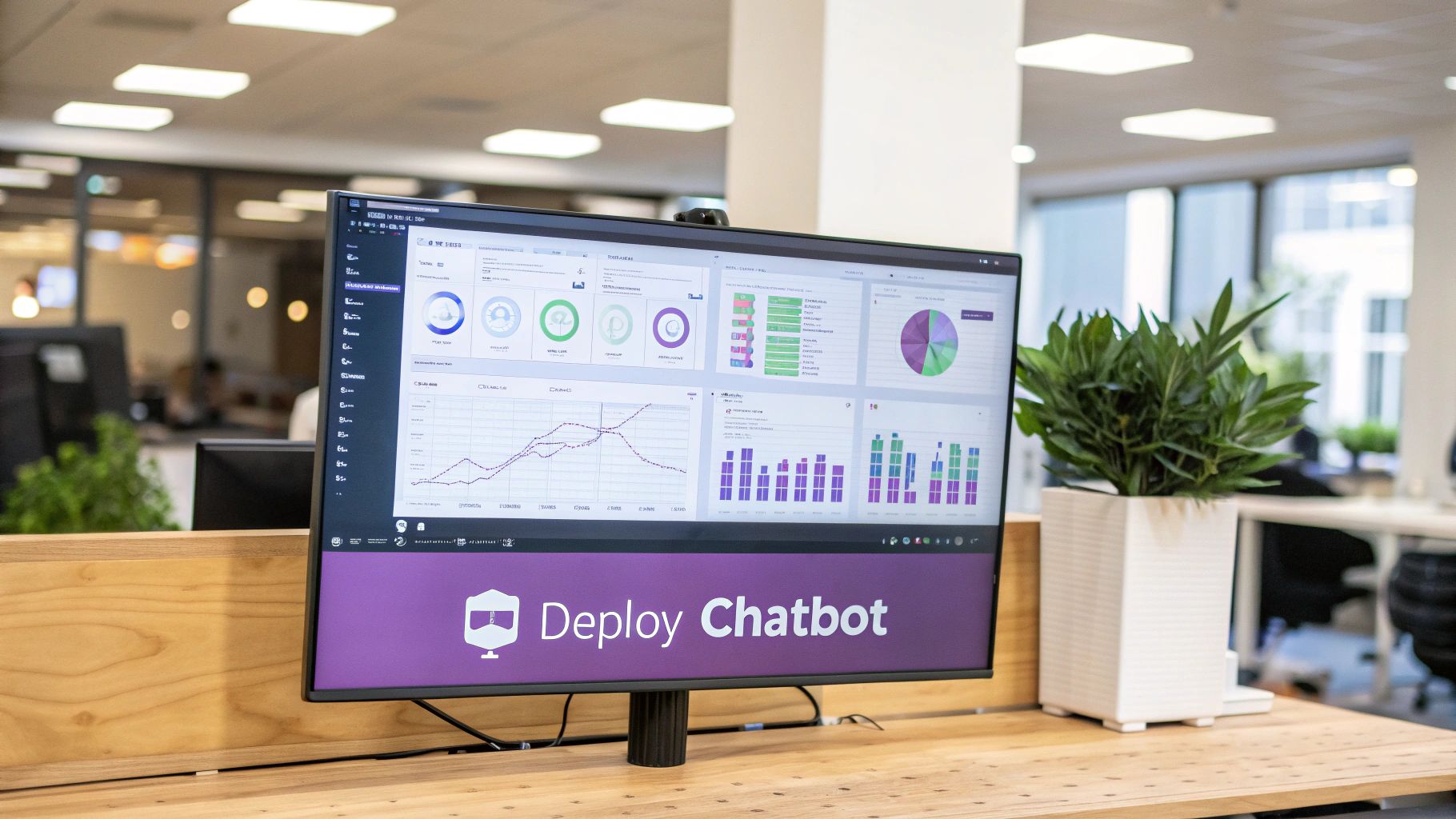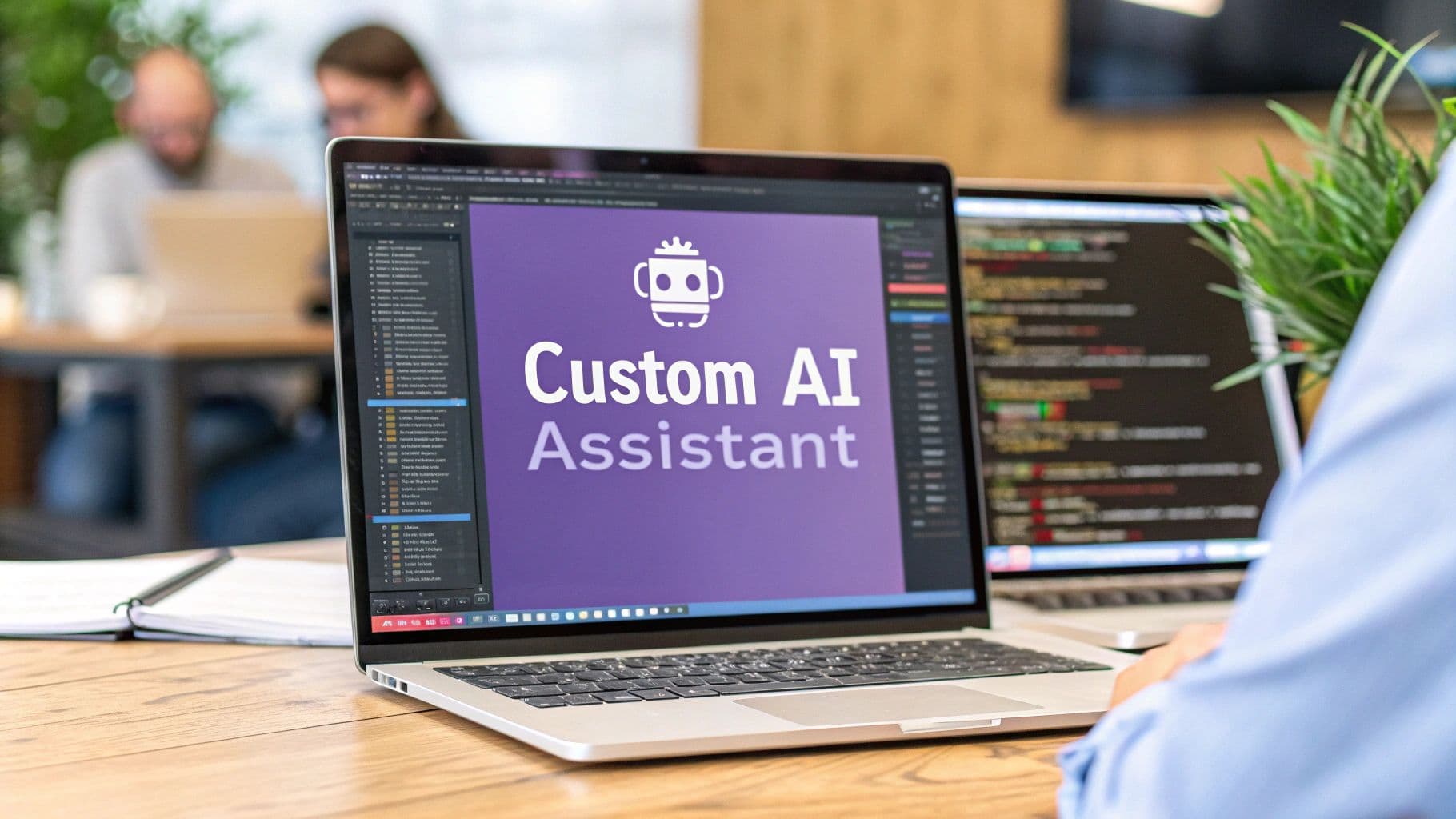Why Smart Businesses Create Their Own Chatbots
The business world is embracing chatbots, such as chatbots for lead generation. Companies recognize the potential to elevate customer experiences, streamline operations, and improve efficiency. However, simply implementing any chatbot isn't enough. Forward-thinking businesses understand the value of creating custom chatbots, tailored to their unique requirements and industry specifics.
This approach offers a degree of control and customization not found in generic, off-the-shelf products. Learn how to start with a free AI chatbot website. This targeted strategy differentiates successful chatbot deployments from expensive, ineffective trials.
Control, Customization, and Competitive Edge
Developing your own chatbot gives you significant control over its features. You decide the conversation flow, the tone of voice, and the specific tasks it manages. This level of customization empowers you to address the particular challenges and capitalize on the unique opportunities within your industry.
For example, a real estate chatbot can be programmed to answer property-specific questions, schedule viewings, and even pre-qualify potential buyers. These are functions a generic bot wouldn't typically offer. This specialized approach generates a substantial competitive advantage.
Furthermore, building a chatbot from scratch enables seamless integration with your existing systems. Whether connecting to your CRM, order management software, or internal knowledge base, a custom chatbot can become a vital component of your workflow. This simplifies processes, reduces manual tasks, and enhances data flow across your organization.
Meeting the Growing Demand for Personalized Experiences
Today's customers anticipate personalized, immediate interactions. A custom-built chatbot fulfills these expectations by delivering instant responses, tailored recommendations, and proactive support. This cultivates stronger customer relationships, boosts loyalty, and ultimately fuels revenue growth.
Importantly, this personalized engagement doesn't need to sacrifice scalability. A well-designed chatbot can manage a high volume of simultaneous interactions, providing consistent service to each customer.
The rising demand for chatbots is evident in the market's rapid expansion. The global chatbot market reached $6.3 billion in 2023, increasing from $5.1 billion in 2022. This demonstrates the widespread adoption of these tools across diverse industries. Find more detailed statistics here This trend highlights the strategic importance of chatbot implementation, and building your own provides the greatest opportunity to maximize their potential.
Scalability and Cost-Effectiveness With Owned Chatbots
Developing your own chatbot might appear to be a considerable investment. However, in the long run, it delivers better scalability and cost-effectiveness compared to using external vendors. With a custom solution, you eliminate recurring subscription fees and per-message charges, which can increase as your business expands.
You also gain the flexibility to modify and enhance your chatbot's capabilities as required, without being limited by a third-party platform. This means you can consistently optimize your chatbot to align with evolving business needs and customer expectations.
Building your own chatbot ensures you retain ownership of your data and maintain complete control over its usage. This is essential for safeguarding sensitive customer information and complying with data privacy regulations. With a custom solution, you dictate how data is collected, stored, and used, giving you increased confidence and building trust with your customers.
Getting Clear On What Your Chatbot Should Actually Do

Before diving into the technical details, it's essential to define your chatbot's core purpose. A well-planned chatbot can be a powerful tool, but a poorly planned one can be a drain on resources. This section highlights the importance of strategy before building.
Defining Your Chatbot's Target Audience
Who will be interacting with your chatbot? Understanding your target audience is the first crucial step. Are you building it for existing customers, potential leads, or internal employees? This knowledge shapes everything from the chatbot's language and tone to its overall functionality. A chatbot for technical support, for instance, will be vastly different from one designed for sales.
This means grasping their needs, technical skills, and preferred communication styles. This understanding will guide how your chatbot interacts with them and helps solve their problems.
Identifying the Problems Your Chatbot Will Solve
Once you know your audience, pinpoint the specific problems your chatbot will tackle. Will it answer FAQs, offer technical support, or guide users through a process? Focusing on specific, solvable problems ensures your chatbot delivers real value.
Trying to do too much at once can hinder its effectiveness. Clearly defined objectives also make it easier to measure the chatbot’s success. This focus allows for targeted development and improvements based on user feedback.
Integrating Your Chatbot with Existing Processes
A successful chatbot doesn't operate in a vacuum. It should integrate smoothly with your existing workflows and systems. Consider how it will interact with your CRM, website, or other platforms.
This integration boosts efficiency and provides a more unified user experience. For example, a customer service chatbot could integrate with your ticketing system. This streamlines support and ensures every customer interaction is tracked and managed effectively. Planning these connections early will save you time and effort down the line.
Mapping Conversation Flows and Setting Realistic Boundaries
A positive user experience relies on carefully planned conversation flows. This means mapping out various interaction scenarios and ensuring your chatbot can handle different user inputs. Think about how it will respond to common questions, manage unexpected requests, and escalate complex issues to human agents.
It's also vital to set realistic boundaries for your chatbot's abilities. Don't aim for a chatbot that can do everything. Start with a focused set of functions and gradually expand its capabilities as you gather data and refine its performance. This iterative approach creates a more robust and useful chatbot in the long run. A clear plan is the foundation for building a chatbot that meets your specific needs and delivers tangible results.
Choosing The Right Tools Without Getting Overwhelmed
Building your own chatbot can feel like navigating a maze. With so many platforms and technologies available, picking the right tools for your specific needs is essential. Making the right choices upfront can save you headaches down the road and set you up for a successful chatbot implementation.
Key Considerations For Platform Selection
The chatbot platform you choose is a foundational decision. It affects not only how you build your chatbot but also its capabilities and how well it can grow with your business. There are several crucial factors to keep in mind.
-
Ease of Use: Consider your technical skills. Do you need a no-code platform like FlowGent AI? Platforms like FlowGent AI allow you to build a chatbot without writing code. Alternatively, if you have developers on your team, a more flexible, code-based framework might be a better fit.
-
Integrations: Connecting your chatbot with your existing systems is key. Think about your CRM, website, and other tools you use. Make sure the chatbot platform you choose can integrate with them.
-
Scalability: Look ahead to the future. Will the platform handle increasing user interactions and more complex chatbot features as your business grows? Scalability is essential for ensuring your chatbot stays effective long-term.
-
Cost: Carefully examine pricing structures, looking out for any hidden fees. Some platforms charge per message or user, while others offer subscription plans. FlowGent AI offers various plans to suit different needs and budgets.
-
Natural Language Processing (NLP) Capabilities: A strong NLP engine is vital for your chatbot to understand and respond to user input effectively. If natural, human-like conversation is a priority, pay close attention to the platform's NLP features.
Comparing Chatbot Platforms
A side-by-side comparison of leading chatbot platforms can significantly simplify your decision-making. This comparison should cover essential features, pricing, integrations, and what each platform is best suited for. To help you with this, we've compiled the following table:
To help you compare different platforms, we've created the following table:
Chatbot Platform Comparison: Features and Pricing A detailed comparison of leading chatbot development platforms showing key features, pricing tiers, integration options, and best use cases
| Platform | Pricing | Key Features | Integration Options | Best For |
|---|---|---|---|---|
| FlowGent AI | Tiered subscriptions | No-code, multi-channel deployment, including AI chatbots for WhatsApp Business, 95+ languages | CRM, website, messaging platforms | Businesses seeking scalable customer support |
| Platform B | Per message/user | Advanced NLP, developer-friendly | API access, custom integrations | Developers building complex chatbots |
| Platform C | Open-source | Customizable, community support | Varies depending on implementation | Tech-savvy users, cost-conscious projects |
This table highlights the key differences and similarities between three popular chatbot platforms. While FlowGent AI shines with its no-code approach and focus on scalability, Platform B offers advanced NLP features for more complex chatbot needs. Platform C caters to tech-savvy users with its open-source nature and flexibility.
Designing Effective Conversation Flows

This image illustrates the process of mapping out a chatbot conversation. Visualizing the flow of interactions – how users might ask questions and how the chatbot should respond – is a valuable step in creating a smooth and user-friendly experience.
Rule-Based Vs. AI-Powered Chatbots: Making The Right Choice
When creating your own chatbot, you’ll face a fundamental choice: You can explore the different types of chatbots. rule-based or AI-powered. Rule-based chatbots follow a set script, ideal for simple tasks like answering frequently asked questions. AI-powered chatbots, on the other hand, use machine learning to handle a broader range of interactions.
This difference is crucial when selecting your platform. Think about how complex your chatbot needs to be. For straightforward scenarios, a rule-based approach might suffice. But for more intricate conversations, an AI-powered chatbot is necessary. FlowGent AI offers the flexibility to build both rule-based and AI-powered chatbots, allowing you to tailor your approach to specific needs.
Building a successful chatbot boils down to carefully considering your needs, comparing available platforms, and understanding the different chatbot architectures. This thoughtful approach will set the stage for a successful implementation.
Making Conversations That Don't Sound Like Robots
Many chatbots miss the mark when it comes to natural conversation. They often come across as robotic and impersonal, lacking the easy flow of human interaction. Creating truly engaging dialogue requires a deep understanding of conversational psychology combined with a grasp of chatbot technology's limitations. This involves understanding user expectations, skillfully managing context, and gracefully handling unexpected conversational turns.
Designing Engaging Interactions
A key element in creating natural-sounding chatbot conversations is structuring interactions intuitively. Successful chatbot designers often use frameworks to guide their dialogue creation. These frameworks prioritize clear conversational pathways, anticipating user needs, and offering helpful prompts along the way.
For example, a chatbot might begin by asking, "How can I help you today?" Then, it might present a menu of options, such as "Check order status," "Browse products," or "Speak to a representative." This structured approach allows users to quickly find the information or assistance they need.
Handling Ambiguous Requests and Managing Context
Users don’t always communicate with perfect clarity. They may use slang, misspell words, or phrase their requests in unexpected ways. A well-designed chatbot must be able to handle these ambiguous requests and accurately interpret user intent. This is where Natural Language Processing (NLP) becomes vital. A robust NLP engine enables the chatbot to understand the meaning behind user input, even if it's imperfectly expressed.
Maintaining context is also crucial. The chatbot should remember previous exchanges within the conversation. For instance, if a user asks about "the blue shoes" after browsing a specific shoe category, the chatbot should understand which shoes are being referenced.
Injecting Personality and Maintaining Professionalism
While maintaining professionalism is paramount, adding personality can significantly enhance the user experience. This might involve using a friendly tone, incorporating appropriate humor, or tailoring the language to reflect the brand's voice. The key is finding the right balance. Too much personality can seem unprofessional, while too little can make the bot feel cold and impersonal.
A travel agency chatbot, for example, could use phrases like, "Dreaming of a getaway?" or "Let's find your perfect adventure!" to inject a sense of excitement. However, it should still maintain its core function of providing accurate information and handling requests efficiently.
Creating Effective Fallback Responses and Smooth Handoffs
Even the most sophisticated chatbots have limitations. When a chatbot reaches its limits, well-crafted fallback responses are crucial to avoid user frustration. Rather than simply stating "I don't understand," the chatbot could offer alternatives. It could suggest rephrasing the question or provide a link to helpful resources.
For more complex issues, the chatbot should seamlessly hand off the conversation to a human agent. This handoff should be smooth and ensure the agent receives the full context of the previous interaction. This prevents customers from repeating themselves and ensures a positive user experience. Learn more in our article about How to master chatbot implementation.
Conversation Repair and User Expectations
Conversation repair involves strategies for getting a conversation back on track when misunderstandings occur. These strategies might include clarifying ambiguous language, acknowledging errors, and offering alternative solutions. Managing user expectations is equally important. Clearly communicating the chatbot's capabilities upfront can prevent frustration. You might be interested in: How to master chatbot training. By focusing on these key elements – from technical expertise to conversational nuance – you can build a chatbot that engages users, delivers value, and creates a positive lasting impression.
Building and Training Your Bot To Actually Work
Building a chatbot isn't just about lines of code. It's about creating a digital assistant that understands and responds effectively to user needs. This involves careful planning, thorough training, and a solid understanding of the technical aspects.
Creating and Organizing Intents and Entities
The core of any effective chatbot lies in its ability to understand user input. This is achieved through intents and entities. Think of intents as the reason behind a user's message. For example, "book a flight" or "check order status" are distinct intents.
Entities, on the other hand, are the specific details within those intents, such as dates, locations, or product names. Clearly defining these details is crucial for accuracy.
Organizing these intents and entities is essential. A well-structured system allows your chatbot to correctly interpret requests and trigger the appropriate responses. This involves grouping similar intents and establishing clear entity hierarchies.
Training Your Chatbot With Quality Data
Just like any employee, your chatbot requires training. This involves feeding it a large dataset of sample conversations. This allows the chatbot to learn how users phrase their requests and what kinds of responses are appropriate. The quality of this data directly impacts its performance.
The more diverse and representative your training data, the better equipped your chatbot will be to handle various user inputs. This may involve gathering data from customer service logs, online forums, or even creating simulated conversations. You might find this helpful: How to master chatbot training.
API Integration, Database Connections, and Business Logic
Your chatbot's capabilities extend beyond simple conversations. Integrating it with APIs and databases allows it to access real-time information and perform actions. This might involve connecting to your CRM software, a payment gateway, or a product database.
Implementing your business logic transforms your chatbot into a valuable tool. This involves defining the rules and processes that govern how your chatbot interacts with your systems and fulfills user requests. It’s the backbone of its functionality.
User Testing, Iteration, and Performance Optimization
Building your chatbot is just the beginning. Rigorous user testing is critical for identifying areas for improvement and ensuring a smooth user experience. Real user feedback helps uncover unforeseen issues.
Iteration is key to ongoing improvement. Use feedback to refine your chatbot's training data, adjust its responses, and optimize its performance. FlowGent AI offers tools to streamline this process, enabling continuous improvement based on real-world interactions.
Understanding The Real Business Impact And ROI

Building your own chatbot isn't just about following the latest trend; it's a strategic business decision. Companies of all sizes are seeing real returns from their chatbot investments. This section explores the financial and competitive advantages of well-implemented chatbots.
Cost Savings and Efficiency Gains
One of the biggest benefits of chatbots is the potential for significant cost savings. By automating routine tasks like answering FAQs and providing basic support, chatbots free up human agents. This allows them to focus on more complex issues, leading to increased efficiency and lower labor costs.
Juniper Research found that chatbots can save businesses an average of four minutes per inquiry. This translates into considerable cost reductions over time.
Furthermore, chatbots offer 24/7 availability. This means consistent support even outside of normal business hours, boosting customer satisfaction and potentially increasing sales and conversions. This constant availability is a major advantage, especially for businesses operating globally.
Revenue Generation Opportunities
Chatbots don't just save money; they can also generate revenue. They can proactively engage with customers to identify upselling and cross-selling opportunities. They also gather valuable customer data that can be used to personalize marketing and improve sales strategies.
For example, a chatbot can suggest related products based on past purchases or browsing history. This personalized approach can greatly improve conversion rates. Chatbots can also qualify leads by collecting information and directing potential customers to the right sales representatives, streamlining the sales process. Read also: How to automate customer support with chatbots.
Competitive Advantage and Market Growth
In today's competitive market, a seamless and personalized customer experience is crucial. Chatbots allow businesses to provide instant support and personalized interactions, building customer loyalty and driving revenue growth. This enhanced customer experience becomes a key competitive differentiator.
Creating a chatbot also means understanding the market. The global AI chatbot market is projected to be worth between $10 billion and $15 billion in 2025, up from $8.3 billion in 2024. Explore this topic further. This growth is driven by chatbot adoption across various industries, with real estate leading at 28% adoption, followed by retail, finance, and healthcare.
ROI Timelines and Sector-Specific Advantages
Chatbot ROI depends on factors like the chatbot's complexity, system integration, and the specific industry. However, many businesses see a positive ROI within the first year. The following table, "Chatbot ROI by Industry Sector," analyzes adoption rates, average cost savings, and ROI metrics across different industries:
To illustrate the sector-specific advantages and ROI timelines, let's examine the following data:
| Industry | Adoption Rate | Average Annual Savings | ROI Timeline | Primary Use Cases |
|---|---|---|---|---|
| Real Estate | High | $20,000 - $50,000 | 6-12 months | lead generation chatbot, property information |
| Retail | Medium | $10,000 - $30,000 | 12-18 months | Customer support, product recommendations |
| Healthcare | Medium | $15,000 - $40,000 | 18-24 months | Appointment scheduling, patient information |
| Finance | Low | $5,000 - $25,000 | 24+ months | Fraud detection, account management |
These figures highlight the potential for significant financial gains and operational improvements across various sectors. Understanding these industry-specific benefits helps businesses make informed decisions about leveraging chatbot technology.
Ready to improve your customer service and boost efficiency? FlowGent AI offers a no-code platform to build powerful AI chatbots that integrate with your existing tools and workflows. Start building your intelligent assistant today!

